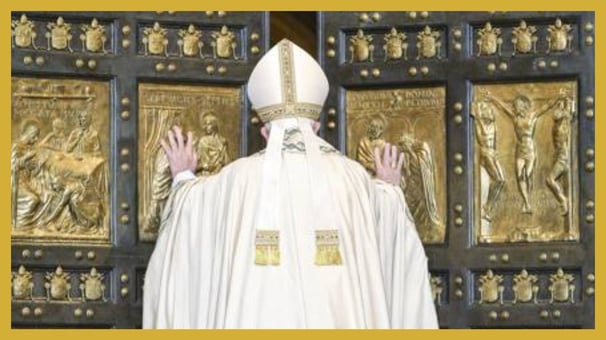Final Ceremony of the 2025 Jubilee: The Closing of the Holy Door
Contents
History of the Holy Door Closing Rite
The Traditional Rite: From the 16th Century to 1975
The 1975 Modification: A New Symbolism
Closing Ceremony of the 2025 Jubilee
Conclusion
The final ceremony of the 2025 Jubilee in Rome will mark the official end of this remarkable Holy Year, with the solemn closure of the Holy Door at Saint Peter's Basilica. This symbolic ritual signifies the conclusion of the spiritual journey for pilgrims participating in the 2025 Jubilee events in Rome. Led by Pope Francis, the ceremony will be a moment of profound religious and historical significance.


History of the Holy Door Closing Rite
The ritual of closing the Holy Door stretches back to the 1500 Jubilee, first conducted during the pontificate of Pope Alexander VI. The ceremonies, as described by Giovanni Burcardo, the Master of Papal Ceremonies, established the template for future Jubilees. Although the ritual evolved over centuries, its core essence persisted unchanged until significant revisions introduced by Pope Paul VI in the 1975 Jubilee.
The Traditional Rite: From the 16th Century to 1975
Before the 1975 Jubilee, the Holy Door's closing involved a solemn ritual incorporating various symbolic elements. The ceremony included:
An entry procession through the Holy Door followed by the celebration of Vespers.
The dispatch of Papal Legates to seal the Holy Doors of the other Papal basilicas: St. John Lateran, St. Mary Major, and St. Paul Outside the Walls.
A procession to the Holy Door of St. Peter, pausing to venerate the relics.
The ceremonial sealing of the Holy Door, with the Pope being the last to exit through it.
A solemn moment in which the Pope blessed and sprinkled holy water on the bricks used to seal the door. Starting with the Jubilee of 1575, three bricks along with gold and silver coins were embedded in the masonry as masons completed the sealing, while the choir sang the hymn “Cœlestis Urbs Jerusalem”.
The celebration concluded with the prayer “Deus qui in omni loco” and the singing of the Te Deum, followed by the Apostolic Blessing imparted from the Loggia of St. Peter.
The 1975 Modification: A New Symbolism
In 1975, Pope Paul VI enacted a pivotal modification to the ritual. The masonry of the door was replaced by the simple closure of the bronze Holy Door panels. This change, rich with deeper social, historical, and biblical significance, redefined the door as a symbol of Christ, "the gate of heaven," moving away from a barrier to be dismantled or rebuilt. Since then, the closing rite has focused on the door itself, symbolizing Christ, the Lord of history.
During Christmas Night of 1975, the rite unfolded in three distinct phases:
Entry into the Basilica through the Holy Door called Porta Sancta Marta, with a pause for prayer at St. Peter's Confession.
A procession through the Basilica and exiting through the Holy Door, accompanied by the chanting of the Laudes Regiæ, with the Pope as the last to leave.
Rites in the atrium, where the Holy Father knelt in prayer at the threshold of the door before closing it with the formula:"Christus heri et hodie, principium et finis; Ipse aperit, et nemo claudit; claudit, et nemo aperit". The ceremony concluded with the procession into St. Peter’s Square for the celebration of the Holy Mass.
Closing Ceremony of the 2025 Jubilee
The closing ceremony of the 2025 Jubilee, rooted in ancient traditions and updated with changes introduced in 1975, will be both a solemn and simple event. The ceremony will commence with a procession to the Holy Door in St. Peter's Basilica. Accompanied by cardinals, deacons, and representatives from the laity across the five continents, the Pope shall lead the procession with a solemn chanting of Psalm 94 (95), after which all participants will assemble in the atrium of the Basilica.
Following the liturgical greeting and a brief prayer, the Holy Father will advance towards the Holy Door, reciting the antiphon "O Clavis David", symbolizing Christ, the key to salvation. The Pope will kneel at the threshold for a moment of silent prayer, before he closes the doors, accompanied by the chant of the acclamation “Christus heri et hodie, Finis et Principium; Christus Alpha et Omega” (Christ yesterday and today, the End and the Beginning; Christ the Alpha and the Omega),
The closure of the Holy Door, signifying Christ as the Lord of history, will mark the conclusion of the Jubilee, yet the spiritual journey of the faithful will persist in the life of the Church. The ceremony will conclude with the celebration of the Holy Mass in St. Peter’s Square and the solemn Apostolic Blessing.
Conclusion
The closure of the Holy Door will symbolically denote the end of the Holy Year, yet the message of grace and reconciliation of the Jubilee will endure in the Church and within the hearts of the faithful. This act extends an invitation to all believers to persevere in their spiritual journey with renewed faith, having passed through the Holy Door as a symbol of conversion and hope.
For additional insights into the main jubilee events, refer to the sections dedicated to Special Jubilee Liturgies and the Opening of the Holy Doors.
Drop us a line
Follow us
Discover the Jubilee
Experience the Jubilee
Jubilee locations
Get ready for the Jubilee
Rome and the Jubilee
